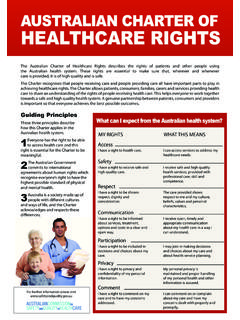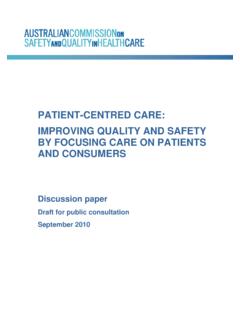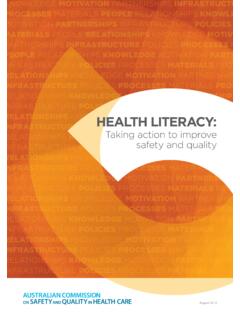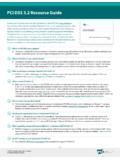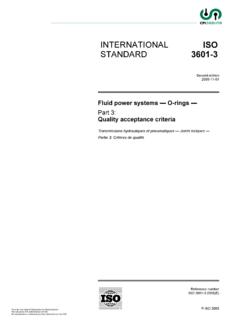Transcription of Safety and Quality Improvement Guide 3
1 3 3. 3 3. Standard 3. Preventing and Controlling Healthcare Associated Infections Safety and Quality Improvement Guide October 2012. 3 3. 3. ISBN: Print: 978-1-921983-31-3. Electronic: 978-1-921983-32-0. Suggested citation: Australian Commission on Safety and Quality in Health Care. Safety and Quality Improvement Guide Standard 3: Preventing and Controlling Healthcare Associated Infections (October 2012). Sydney. ACSQHC, 2012. Commonwealth of Australia 2012. This work is copyright. It may be reproduced in whole or in part for study or training purposes subject to the inclusion of an acknowledgement of the source. Requests and inquiries concerning reproduction and rights for purposes other than those indicated above requires the written permission of the Australian Commission on Safety and Quality in Health Care: Australian Commission on Safety and Quality in Health Care GPO Box 5480. Sydney NSW 2001.
2 Email: Acknowledgements This document was prepared by the Australian Commission on Safety and Quality in Health Care in collaboration with numerous expert working groups, members of the Commission's standing committees and individuals who generously gave of their time and expertise. The Commission wishes to acknowledge the work of its staff in the development of this document. Table of Contents The National Safety and Quality Health Service standards 2. Terms and definitions 5. Standard 3: Preventing and Controlling Healthcare Associated Infections 7. Criterion: Governance and systems for infection prevention, control and surveillance 9. Criterion: Infection prevention and control strategies 15. Criterion: Managing patients with infections or colonisations 26. Criterion: Antimicrobial stewardship 32. Criterion: Cleaning, disinfection and sterilisation 48. Criterion: Communicating with patients and carers 54.
3 References 56. Appendix: Links to resources 57. Standard 3: Preventing and Controlling Healthcare Associated Infections The National Safety and Quality Health Service standards The National Safety and Quality Health Service The Guides present suggestions for meeting the (NSQHS) Standards1 were developed by the Australian criteria of the standards , which should not be Commission on Safety and Quality in Health Care interpreted as being mandatory. The examples of (the Commission) in consultation and collaboration suggested strategies and outputs of Improvement with jurisdictions, technical experts and a wide range processes are examples only. In other words, health of other organisations and individuals, including health service organisations can choose Improvement actions professionals and patients. that are specific to their local context in order to achieve the criteria. The extent to which Improvement The primary aims of the NSQHS standards are is required in your organisation will heavily influence to protect the public from harm and to improve the actions, processes and projects you undertake.
4 The Quality of care provided by health service organisations. These standards provide: You may choose to demonstrate how you meet the criteria in the standards using the example a Quality assurance mechanism that tests whether outputs of Improvement processes, or alternative relevant systems are in place to ensure minimum examples that are more relevant to your own Quality standards of Safety and Quality are met Improvement processes. a Quality Improvement mechanism that allows health service organisations to realise Additional resources developmental goals. The Commission has developed a range of resources to assist health service organisations to implement the Safety and Quality NSQHS standards . These include: Improvement Guides a list of available resources for each of the The Commission has developed Safety and Quality NSQHS standards Improvement Guides (the Guides) for each of the 10.
5 NSQHS standards . These Guides are designed to an Accreditation Workbook for Hospitals assist health service organisations to align their Quality and an Accreditation Workbook for Day Improvement programs using the framework of the Procedure Services NSQHS standards . A Guide for Dental Practices (relevant only to The Guides are primarily intended for use by standards 1 6). people who are responsible for a part or whole a series of fact sheets on the NSQHS standards of a health service organisation. The structure of the Guides includes: frequently asked questions introductory information about what is required to a list of approved accrediting agencies achieve each criterion of the Standard slide presentations on the NSQHS standards . tables describing each action required and listing: key tasks implementation strategies examples of the outputs of Improvement processes additional supporting resources (with links to Australian and international resources and tools, where relevant).
6 Direct links to these and other useful resources are available on the Commission's web site: 2 | Australian Commission on Safety and Quality in Health Care Quality Improvement Overarching NSQHS approaches in health care standards Approaches to improving healthcare Quality and Standard 1: Governance for Safety and Safety are well documented and firmly established. Quality in Health Service Organisations, Examples of common approaches include Clinical and Standard 2: Partnering with Consumers Practice Improvement or Continuous Quality set the overarching requirements for the Improvement . The Guides are designed for use in effective application of the other eight the context of an overall organisational approach NSQHS standards which address specific to Quality Improvement , but are not aligned to any clinical areas of patient care. particular approach. Standard 1 outlines the broad criteria Further information on adopting an appropriate Quality to achieve the creation of an integrated Improvement methodology can be found in the: governance system to maintain and improve NSW Health Easy Guide to Clinical Practice the reliability and Quality of patient care, and Improvement 2.
7 Improve patient outcomes. CEC Enhancing Project Spread and Sustainability3. Standard 2 requires leaders of a health service organisation to implement systems to support Institute for Healthcare Improvement (US) 4. partnering with patients, carers and other consumers to improve the Safety and Quality of care. Patients, carers, consumers, clinicians and other members of the workforce should use the systems for partnering with consumers. Core and developmental actions The NSQHS standards apply to a wide variety of health service organisations. Due to the variable size, structure and complexity of health service delivery models, a degree of flexibility is required in the application of the standards . To achieve this flexibility, each action within a Standard is designated as either: CORE. considered fundamental to safe practice OR. DEVELOPMENTAL. areas where health service organisations can focus activities or investments that improve patient Safety and Quality .
8 Information about which actions have been designated as core or developmental is available on the Commission's web site. Standard 3: Preventing and Controlling Healthcare Associated Infections | 3. Standard 3: Preventing and Controlling Healthcare Associated Infections The National Safety and Quality Health Service standards (continued). Roles for Safety and Quality in health care A range of participants are involved in ensuring the The role of the non-clinical workforce is safe and effective delivery of healthcare services. important to the delivery of Quality health care. These include the following: This group may include administrative, clerical, Patients and carers, in partnership with health cleaning, catering and other critical clinical support service organisations and their healthcare staff or volunteers. By actively participating providers, are involved in: in organisational processes including the development and implementation of Safety making decisions for service planning systems, Improvement initiatives and related developing models of care training this group can help to identify and measuring service and evaluating systems address the limitations of Safety systems.
9 A key of care. role for the non-clinical workforce is to notify They should participate in making decisions about clinicians when they have concerns about a their own health care. They need to know and patient's condition. exercise their healthcare rights, be engaged in their The role of managers in health service healthcare, and participate in treatment decisions. organisations is to implement and maintain Patients and carers need to have access to systems, resources, education and training information about options and agreed treatment to ensure that clinicians deliver safe, effective plans. Health care can be improved when patients and reliable health care. They should support and carers share (with their healthcare provider) the establishment of partnerships with patients issues that may have an impact on their ability and carers when designing, implementing and to comply with treatment plans.
10 Maintaining systems. Managing performance and facilitating compliance across the organisation is a The role of clinicians is essential. Improvements to key role. This includes oversight of individual areas the system can be achieved when clinicians actively with responsibility for the governance of Safety participate in organisational processes, Safety and Quality systems. Managers should be leaders systems, and Improvement initiatives. Clinicians who can model behaviours that optimise safe and should be trained in the roles and services for high Quality care. Safer systems can be achieved which they are accountable. Clinicians make health when managers in health service organisations systems safer and more effective if they: consider Safety and Quality implications in their have a broad understanding of their decision making processes. responsibility for Safety and Quality in healthcare follow Safety and Quality procedures The role of health service senior executives and owners is to plan and review integrated supervise and educate other members of governance systems that promote patient Safety the workforce and Quality , and to clearly articulate organisational participate in the review of performance and individual Safety and Quality roles and procedures individually, or as part of a team.





